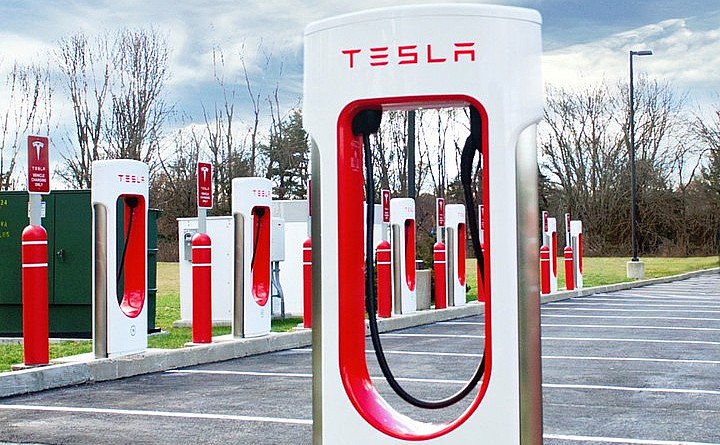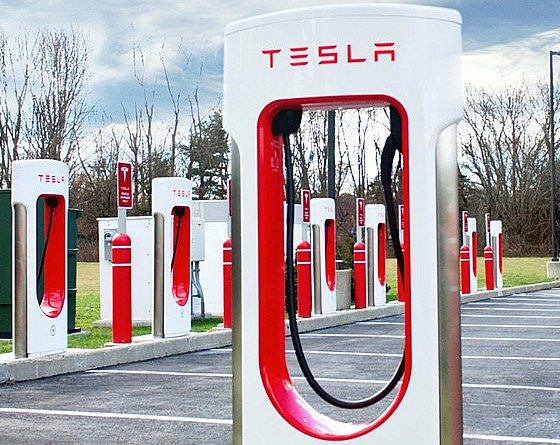

News
Tesla Supercharger Network allows Model 3 owner to travel from NY to FL for less than $70
One of Tesla’s biggest advantages in the electric vehicle sector is arguably its Supercharger Network, which allows vehicles to recharge their batteries in a convenient, rapid, and affordable fashion. This was highlighted recently by a Model 3 owner who spent less than $70 in Supercharging fees during a two-day trip that spanned over 1,200 miles, from Buffalo, NY to Melbourne, FL.
Tesla owner Richard Clements shared some insights about his 1,248-mile drive in a recent post on the Tesla Owners Club New York State blog. According to the Tesla owner, the trip was not difficult at all, especially since the Model 3 provided all the information necessary to ensure that the vehicle always had sufficient charge.
Thanks to the Supercharger Network’s reasonable rates, the Model 3 owner only spent an average of $0.25/kWh during the New York to Florida trip. This meant that over the course of the two-day drive, Clements only spent a total of $69.96 in Supercharger fees. The Tesla owner noted that this amount was about half of what he used to spend when he was still making the trip with his Jaguar or CR-V. Even with low fuel prices, Clements noted that he would spend about $140 in fuel costs.
The Model 3’s total charging time at Tesla Superchargers stood at about 207 minutes, though 40 minutes of this was done in a hotel, where Clements spent the night. With this in consideration, the Tesla owner noted that the effective charging time of the Model 3 was actually just around 167 minutes. Based on his driving behavior, which involves stopping for bathroom and food breaks every 3.5 hours or so, the Tesla owner noted that the Model 3’s downtime was comparable to his previous ICE vehicles.
“To make a valid time comparison though, our Supercharging time in Wytheville VA was done right in the parking lot of the hotel where we were spending the night, so that charging time had no effect on our overall travel time. Deducting those 40 minutes makes the effective time 167 minutes. To make a valid comparison, there has to be some downtime on a trip like this. Any ICE vehicle still needs about 10 minutes to refuel at least 3 times on a trip of 1,250 miles, so by my estimate that’s 30 minutes for refueling.
“Also, as a practical matter, we don’t generally last more than about 3.5 hours without a need for plumbing or something to eat, so generally, we’d also be stopping for some meals… Assuming lunch and other miscellaneous breaks on our Florida run, that would easily account for about another 2 hours of downtime. So adding those two hours to the gasoline refueling time, the total would be 160 minutes. That compares to the 167 minutes in our Tesla—only an insignificant 7 minute’s difference,” Clements concluded.
Tesla’s ramp of its Supercharger Network would likely accelerate this year, particularly as the company doubles down on the expansion of its V3 chargers across the United States. Overseas, Tesla’s charging network is also making waves, with the electric car maker establishing a dedicated Supercharger factory just a few miles from Gigafactory Shanghai. The facility is expected to have an output of 10,000 Superchargers per year.
Clements’ full account of his sub-$70, 1,248-mile drive from Buffalo, NY to Melbourne, FL could be accessed here.
Don’t hesitate to contact us for news tips. Just send a message to the Teslarati team through tips@teslarati.com to give us a heads up.

News
Tesla FSD fleet is nearing 7 billion total miles, including 2.5 billion city miles
As can be seen on Tesla’s official FSD webpage, vehicles equipped with the system have now navigated over 6.99 billion miles.

Tesla’s Full Self-Driving (Supervised) fleet is closing in on almost 7 billion total miles driven, as per data posted by the company on its official FSD webpage.
These figures hint at the massive scale of data fueling Tesla’s rapid FSD improvements, which have been quite notable as of late.
FSD mileage milestones
As can be seen on Tesla’s official FSD webpage, vehicles equipped with the system have now navigated over 6.99 billion miles. Tesla owner and avid FSD tester Whole Mars Catalog also shared a screenshot indicating that from the nearly 7 billion miles traveled by the FSD fleet, more than 2.5 billion miles were driven inside cities.
City miles are particularly valuable for complex urban scenarios like unprotected turns, pedestrian interactions, and traffic lights. This is also the difference-maker for FSD, as only complex solutions, such as Waymo’s self-driving taxis, operate similarly on inner-city streets. And even then, incidents such as the San Francisco blackouts have proven challenging for sensor-rich vehicles like Waymos.
Tesla’s data edge
Tesla has a number of advantages in the autonomous vehicle sector, one of which is the size of its fleet and the number of vehicles training FSD on real-world roads. Tesla’s nearly 7 billion FSD miles then allow the company to roll out updates that make its vehicles behave like they are being driven by experienced drivers, even if they are operating on their own.
So notable are Tesla’s improvements to FSD that NVIDIA Director of Robotics Jim Fan, after experiencing FSD v14, noted that the system is the first AI that passes what he described as a “Physical Turing Test.”
“Despite knowing exactly how robot learning works, I still find it magical watching the steering wheel turn by itself. First it feels surreal, next it becomes routine. Then, like the smartphone, taking it away actively hurts. This is how humanity gets rewired and glued to god-like technologies,” Fan wrote in a post on X.
News
Tesla starts showing how FSD will change lives in Europe
Local officials tested the system on narrow country roads and were impressed by FSD’s smooth, human-like driving, with some calling the service a game-changer for everyday life in areas that are far from urban centers.

Tesla has launched Europe’s first public shuttle service using Full Self-Driving (Supervised) in the rural Eifelkreis Bitburg-Prüm region of Germany, demonstrating how the technology can restore independence and mobility for people who struggle with limited transport options.
Local officials tested the system on narrow country roads and were impressed by FSD’s smooth, human-like driving, with some calling the service a game-changer for everyday life in areas that are far from urban centers.
Officials see real impact on rural residents
Arzfeld Mayor Johannes Kuhl and District Administrator Andreas Kruppert personally tested the Tesla shuttle service. This allowed them to see just how well FSD navigated winding lanes and rural roads confidently. Kruppert said, “Autonomous driving sounds like science fiction to many, but we simply see here that it works totally well in rural regions too.” Kuhl, for his part, also noted that FSD “feels like a very experienced driver.”
The pilot complements the area’s “Citizen Bus” program, which provides on-demand rides for elderly residents who can no longer drive themselves. Tesla Europe shared a video of a demonstration of the service, highlighting how FSD gives people their freedom back, even in places where public transport is not as prevalent.
What the Ministry for Economic Affairs and Transport says
Rhineland-Palatinate’s Minister Daniela Schmitt supported the project, praising the collaboration that made this “first of its kind in Europe” possible. As per the ministry, the rural rollout for the service shows FSD’s potential beyond major cities, and it delivers tangible benefits like grocery runs, doctor visits, and social connections for isolated residents.
“Reliable and flexible mobility is especially vital in rural areas. With the launch of a shuttle service using self-driving vehicles (FSD supervised) by Tesla in the Eifelkreis Bitburg-Prüm, an innovative pilot project is now getting underway that complements local community bus services. It is the first project of its kind in Europe.
“The result is a real gain for rural mobility: greater accessibility, more flexibility and tangible benefits for everyday life. A strong signal for innovation, cooperation and future-oriented mobility beyond urban centers,” the ministry wrote in a LinkedIn post.
News
Tesla China quietly posts Robotaxi-related job listing
Tesla China is currently seeking a Low Voltage Electrical Engineer to work on circuit board design for the company’s autonomous vehicles.

Tesla has posted a new job listing in Shanghai explicitly tied to its Robotaxi program, fueling speculation that the company is preparing to launch its dedicated autonomous ride-hailing service in China.
As noted in the listing, Tesla China is currently seeking a Low Voltage Electrical Engineer to work on circuit board design for the company’s autonomous vehicles.
Robotaxi-specific role
The listing, which was shared on social media platform X by industry watcher @tslaming, suggested that Tesla China is looking to fill the role urgently. The job listing itself specifically mentions that the person hired for the role will be working on the Low Voltage Hardware team, which would design the circuit boards that would serve as the nervous system of the Robotaxi.
Key tasks for the role, as indicated in the job listing, include collaboration with PCB layout, firmware, mechanical, program management, and validation teams, among other responsibilities. The role is based in Shanghai.
China Robotaxi launch
China represents a massive potential market for robotaxis, with its dense urban centers and supportive policies in select cities. Tesla has limited permission to roll out FSD in the country, though despite this, its vehicles have been hailed as among the best in the market when it comes to autonomous features. So far, at least, it appears that China supports Tesla’s FSD and Robotaxi rollout.
This was hinted at in November, when Tesla brought the Cybercab to the 8th China International Import Expo (CIIE) in Shanghai, marking the first time that the autonomous two-seater was brought to the Asia-Pacific region. The vehicle, despite not having a release date in China, received a significant amount of interest among the event’s attendees.








